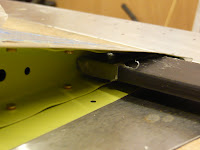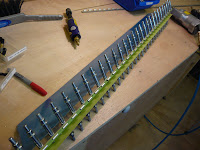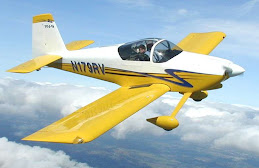Set last rivets at narrow end of elevator root and tip ribs except for the very last ones. Experimented with techniques for these last rivets.
 The long-nose no-hole yoke is the obvious tool for this job and does well up to a point (yes that was a pun) where there is just not enough room for the unsqueezed shop end of the rivet as well as the pointy end of the yoke within the flanges of the rib down near the trailing edge.
The long-nose no-hole yoke is the obvious tool for this job and does well up to a point (yes that was a pun) where there is just not enough room for the unsqueezed shop end of the rivet as well as the pointy end of the yoke within the flanges of the rib down near the trailing edge.On most of them, I was able to get the yoke nose in as long as the rivet was not fully inserted. You are then depending on getting the moving rivet set to push the rivet home as it closes before finally setting the rivet at the end of its travel. To do this, you have to have pretty good trigger control skills to get the squeezer to close slowly. Even then, I found that the skin and rib were not tight to each other at the point where the rivet set enough to grab the inside of the holes. These all had to be drilled out, leaving me with only one of the eight where the results were okay. To make matters worse, if you do happen to get one of these set, the rivet head now restricts the space further for setting the rivet on the surface opposite.
 I decided to try the 'lever' method so I put some tape around the end of a piece of flat steel bar that I had. However, this wasn't really stiff enough to set the rivet properly, leading to some more drilled out rivets. I will have to look at using a wide 'bolster' masonry chisel, which should be really hard while still being thin enough to get into the space available. Also, I need a rubber grommet with a thickness closely matching the projecting shop tail of the rivet. Placed over the rivet tail, this will push down on the rib flange making sure that the two materials are in close contact as the rivet 'bites'.
I decided to try the 'lever' method so I put some tape around the end of a piece of flat steel bar that I had. However, this wasn't really stiff enough to set the rivet properly, leading to some more drilled out rivets. I will have to look at using a wide 'bolster' masonry chisel, which should be really hard while still being thin enough to get into the space available. Also, I need a rubber grommet with a thickness closely matching the projecting shop tail of the rivet. Placed over the rivet tail, this will push down on the rib flange making sure that the two materials are in close contact as the rivet 'bites'.That's it with the project for the moment. I really need to help Dorothy out with the remodelling job so I will have to stop work until that is done and the wings arrive. I still have these rivets to finish plus I haven't rolled the forward edge of the rudder skins. Still, building a plane doesn't mean you are no longer a member of the family and duty calls.
















